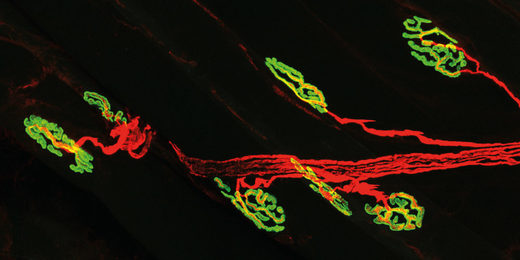Strength training might come at the expense of endurance muscles
University of Basel
Thu, 25 Jul 2019 12:00 UTC

© University of Basel, Biozentrum
The neuromuscular junction (NMJ): innervation of the acetycholine receptors (green) on the muscle fiber by the motor neuron (red).
The neurotransmitter brain-derived neurotrophic factor (BDNF) acts in the muscle, so that during strength training endurance muscle fiber number is decreased. Researchers at the University of Basel's Biozentrum have more closely investigated this factor, from the group of myokines, and demonstrated that it is produced by the muscle and acts on both muscles and synapses. The results published in PNAS also provide new insights into age-related muscle atrophy.
Fitness clubs are booming: New gyms are springing up like mushrooms. More and more people are striving to build up and strengthen their muscles. But what exactly happens in the muscle during training? In their recent work, Prof. Christoph Handschin's research group at the Biozentrum, University of Basel, has more closely studied strength muscles and the myokine brain-derived neurotrophic factor (BDNF), which plays an important role in the formation of strength muscle fibers.
Handschin's team has demonstrated that
this factor is produced by the muscle itself and remodels the neuromuscular synapses, the neuronal junctions between the motor neurons and muscle. BDNF not only causes the strength muscles to develop, but at the same time leads to endurance muscle fiber number decline.
BDNF acts on muscles and synapses
Generally, it is differentiated between two types of muscle, depending on the type of fibers they are made of:
There are the slow-twitch fibers for endurance muscles, which are formed mainly during endurance sports. Marathon runners primarily exercise this type of muscle. A great deal less well studied is the second form of muscle consisting of fast-twitch fibers. These strength muscles gain in volume during strength training and provide particularly great muscular power.
Christoph
Handschin's team has now studied the hormone-like neurotransmitter from the myokine family in the mouse model. Myokines are released by the muscle during contraction. "It is interesting that BDNF is produced by the muscle itself and not only exerts an influence on the muscle. At the same time, it affects the neuromuscular synapses, which are the junctions between the motor neurons and muscle," explains Handschin.
BDNF converts endurance muscles into strength muscles
This remodeling of the neuromuscular synapses during strength training results in the body developing more strength muscle fibers. "However, strength muscle growth occurs at the expense of the endurance fibers.
More precisely, through the release of BDNF, the endurance muscles are transformed into strength muscles", clarifies Handschin. This makes BDNF a factor proven to be produced by the muscle itself and to influence the type of muscle fibers formed.
Relevance to muscle training and age-related muscle atrophy
The new knowledge gained about the myokine BDNF also provides a possible explanation for the decrease in endurance musculature seen as a result of strength training. This correlation is already being taken into account in the training plan for high performance sports. Particularly in
sporting disciplines such as rowing, which are geared towards strength and endurance, the muscle remodeling must be considered.
Moreover, in a follow-up study, the research group showed that
in muscle lacking BDNF the age-related decline in muscle mass and function is reduced. "We didn't expect this result", says Handschin. "It also makes the findings interesting for treatment approaches for muscle atrophy in the elderly."







 I time the stretches and for 45 seconds I stretch my legs to the point of increasing discomfort. For the final 15 seconds I push as hard as possible, even though it hurts very much and my legs are trembling. I sometimes do the stretches for 90-120 seconds in each position. It's only been a month and I can comfortably grab my foot when my legs are straight on the floor
I time the stretches and for 45 seconds I stretch my legs to the point of increasing discomfort. For the final 15 seconds I push as hard as possible, even though it hurts very much and my legs are trembling. I sometimes do the stretches for 90-120 seconds in each position. It's only been a month and I can comfortably grab my foot when my legs are straight on the floor  " but what I actually mean is getting not-huge. Which is why it's funny. Um, to me, anyway...
" but what I actually mean is getting not-huge. Which is why it's funny. Um, to me, anyway...